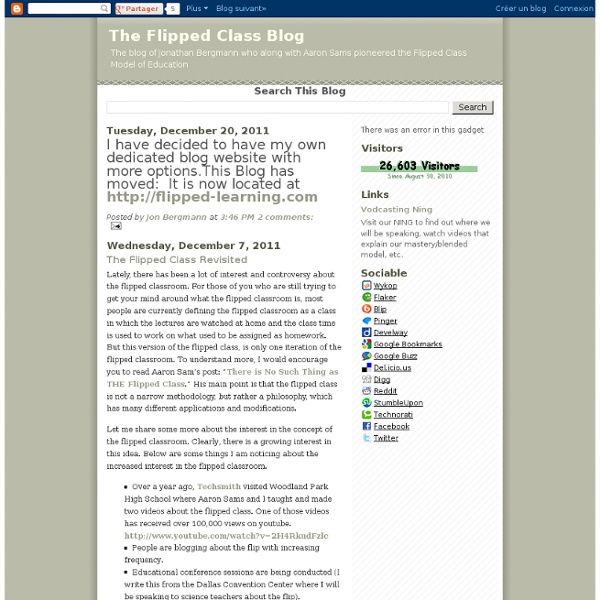



JeffLebow.net The Flipped Classroom Infographic What is the meaning of “Flipped Classroom”? Well below you will see exactly what a flipped classroom is and what benifits it has for our kids in school. Basically the idea is to turn traditional education on its head and start fresh with new modern teaching practices. Many educators are experimenting with the idea of a ‘Flipped Classroom’ model already.. David Wicks: Educational Technology Five Best Practices for the Flipped Classroom Ok, I'll be honest. I get very nervous when I hear education reformists and politicians tout how "incredible" the flipped-classroom model, or how it will "solve" many of the problems of education. It doesn't solve anything. It is a great first step in reframing the role of the teacher in the classroom. It fosters the "guide on the side" mentality and role, rather than that of the "sage of the stage." It also creates the opportunity for differentiated roles to meet the needs of students through a variety of instructional activities. 1) Need to Know How are you creating a need to know the content that is recorded? 2) Engaging Models One of the best way to create the "need to know" is to use a pedagogical model that demands this. 3) Technology What technology do you have to support the flipped classroom? 4) Reflection 5) Time and Place Do you have structures to support this? I know I may have "upset the apple cart" for those who love the flipped classroom.
Flipped Classroom Educational Technology Guy Creating interactive online video using YouTube YouTube doesn’t have to be a place where viewers passively watch video. Free annotation tools allow content creators to provide interactive opportunities to engage content. The resulting video can be used as part of a flipped classroom model or to time-shift any kind of instruction. This video tutorial shows you exactly how to create buttons that can be placed on your video to jump forwards and backwards within the timeline. Demonstration #1: Interactive Flipped Instruction Here is an example of an interactive lesson on fractions that use YouTube annotations to create a quick self-quiz. Demonstration #2: Chapter Markers in YouTube Here is an example of a video that covers several different topics and includes an introductory table of contents that can be accessed at any time. Demonstration #3: Allow viewers to create their own content Final example is fun but also a powerful example of the freedom that interactivity allows.
How to Learn Spanish Online for Free Présentation | Classe Inversée Ce site a pour but d’expliquer le concept de classe inversée à tous les professeurs qui souhaitent avoir un réel impact auprès de leurs élèves et qui veulent connaitre les meilleures méthodes pour développer une ambiance de classe motivante et décontractée. Exemple de classe inversée Ce concept connait un succès grandissant : de plus en plus de professeurs à travers le monde modifient leur façon de “faire la classe” pour passer à un modèle plus pratique et plus humain. Ce modèle part d’une idée très simple : le précieux temps de classe serait mieux utilisé si on s’en servait pour interagir et travailler ensemble plutôt que de laisser une seule personne parler. La classe inversée : plus qu’une méthode, une philosophie Professeur guidant un groupe de travail Il s’agit donc davantage d’une philosophie que d’une méthode à proprement parler. Un modèle plus humain Les interactions deviennent plus conviviales Les avantages de ce modèle sont multiples, mais le principal est la liberté qu’il procure.